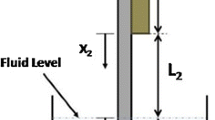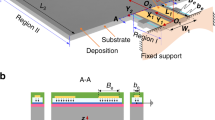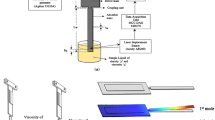Abstract
Resonant piezoelectric-excited millimeter-sized cantilevers (PEMCs) have attracted many researchers’ interests in the applications such as liquid level and density sensing. As in these applications, the PEMC’s are partially immersed in liquid; an appropriate analytical model is needed to predict the dynamic behavior of these devices. In this work, a PEMC is designed and fabricated to be used as a liquid level sensing platform. An analytical model is developed and applied to evaluate the behavior of this device with respect to different tip immersion depths. To validate the proposed model, the theoretical and experimental results are compared for the tip immersion depths varying from 5 to 15 mm in water for two different resonant modes. To justify the deviations observed between the theoretical model and the experimental results, uncertain parameters and a correction factor for hydrodynamic force are introduced in theoretical model. To determine these parameters using experimental results, particles swarm optimization method is utilized. Applying this method, the deviation of theoretical results from experimental data is being significantly reduced. The results show that the uncertain parameters have negligible effect on the resonant frequency shift of the PEMC in different immersion depths, whereas the correction factor related to the hydrodynamic force affects it drastically. It is concluded that to improve the accuracy of the frequency domain modeling of PEMC partially immersed in liquid, for different immersion depths, an appropriate estimation of liquid force is required by insertion of hydrodynamic correction factor.













Similar content being viewed by others

Abbreviations
- w 1 :
-
Transverse displacement of beam in region A in time domain
- w 2 :
-
Transverse displacement of beam in region B in time domain
- w 3 :
-
Transverse displacement of beam in region C in time domain
- W 1 :
-
Transverse displacement of beam in region A in frequency domain
- W 2 :
-
Transverse displacement of beam in region B in frequency domain
- W 3 :
-
Transverse displacement of beam in region C in frequency domain
- t a :
-
Thickness of adhesive layer
- t b :
-
Thickness of the beam
- t p :
-
Thickness of piezoelectric layer
- b :
-
Width of the cantilever
- L 1 :
-
Length of the region A
- L 2 :
-
Length of the region B
- L 3 :
-
Length of the region C
- A p :
-
Piezoelectric parch cross section area
- A b :
-
Beam cross section area
- A ad :
-
Adhesive layer cross section
- ρ a :
-
Density of adhesive layer
- ρ b :
-
Density of beam
- ρ p :
-
Density of piezoelectric patch
- ρ F :
-
Density of liquid
- Y p :
-
Young Modulus of piezoelectric patch
- ω :
-
Radial frequency
- Y b :
-
Young modulus of the beam
- E 3 :
-
Electrical field in Z direction in the piezoelectric patch
- V :
-
Applied electrical voltage
- I b :
-
Second moment of inertia of beam
- I be :
-
Second moment of inertia of beam about neutral axis in region A
- I pe :
-
Second moment of inertia of piezoelectric patch about neutral axis in region A
- YI) eq.e :
-
Equivalent stiffness of the beam plus adhesive layer about neutral axis in region A
- σ 1 :
-
Longitudinal stress in region A
- ε 1 :
-
Longitudinal strain in region A
- Γ(ω):
-
Hydrodynamic function
- \(\varepsilon_{33}^{S}\) :
-
Dielectric constant of piezoelectric patch under constant strain
- \(\varepsilon_{33}^{T}\) :
-
Dielectric constant of piezoelectric patch under constant stress
- d 31 :
-
Piezoelectric constant
- D 3 :
-
Electrical displacement along piezoelectric patch thickness
- φ :
-
Electrical potential along Piezoelectric patch thickness
- ρ w :
-
Density of water
- μ w :
-
Dynamic viscosity of water
- x 1 :
-
Coordinate along the region A
- x 2 :
-
Coordinate along the region B
- x 3 :
-
Coordinate along the region C
- Z :
-
Coordinate along the piezoelectric patch thickness
References
Rijal, K., & Mutharasan, R. (2007). Piezoelectric-excited millimeter-sized cantilever sensors detect density differences of a few micrograms/mL in liquid medium. Sensors and Actuators B, 124, 237–244.
Riesch, C., Reichel, E. K., Keplinger, F., & Jakoby, B. (2008). Characterizing vibrating cantilevers for liquid viscosity and density sensing. Hindawi Publishing Corporation Journal of Sensors, 2008.
Shih, W. Y., Li, X., Gu, H., Shih, W.-H., & Aksay, I. A. (2001). Simultaneous liquid viscosity and density determination with piezoelectric unimorph cantilevers. Journal of Applied Physics, 89(2), 1497–1505.
Campbell, G. A., & Mutharasan, R. (2005). Sensing of liquid level at micron resolution using self-excited millimeter-sized PZT cantilever. Sensors and Actuators A, 122, 326–334.
Basak, S., Raman, A., & Garimella, S. V. (2005). Dynamic response optimization of piezoelectrically excited thin resonant beams. Transactions of the ASME, Journal of Vibration and Acoustics, 127, 18–27.
Sader, J. E. (1998). Frequency response of cantilever beams immersed in viscous fluids with applications to the atomic force microscope. Journal of Applied Physics, 84(1), 64–76.
Preumont, A. (2002). Vibration control of active structures (2nd ed., pp. 41–44). Dordrecht: Kluwer Academic Publishers.
Rao, S. S. (2007). Vibration of continuous systems (pp. 321–338). Hoboken: Wiley.
Banks, H. T., & Inman, D. J. (1994). On damping mechanisms in beams. Journal of Applied Mechanics, Transactions of the ASME, 58, 716–723.
Cheng, Nian-Sheng. (2008). Formula for the viscosity of a glycerol-water mixture. Industrial and Engineering Chemistry Research, 47, 3285–3288.
Shu, J., & Li, J. (2009). An improved self-adaptive particle swarm optimization algorithm with simulated annealing. In Third international symposium on intelligent information technology application. doi:10.1109/IITA.2009.476.
Ratnaweera, A., Halgamuge, S. K., & Watson, H. C. (2004). Self-organizing hierarchical particle swarm optimizer with time-varying acceleration coefficients. IEEE Transactions on Evolutionary Computation, 8(3), 240–255.
Shi, Y., & Eberhart, R. (1998). A modified particle swarm optimizer. IEEE.0-7803-4869-9198.
Author information
Authors and Affiliations
Corresponding author
Rights and permissions
About this article
Cite this article
Maroufi, M., Shamshirsaz, M. Resonant behavior study of PZT sensor partially immersed in liquid using PSO method: modeling and experiment. Analog Integr Circ Sig Process 82, 583–597 (2015). https://doi.org/10.1007/s10470-015-0504-4
Received:
Revised:
Accepted:
Published:
Issue Date:
DOI: https://doi.org/10.1007/s10470-015-0504-4



